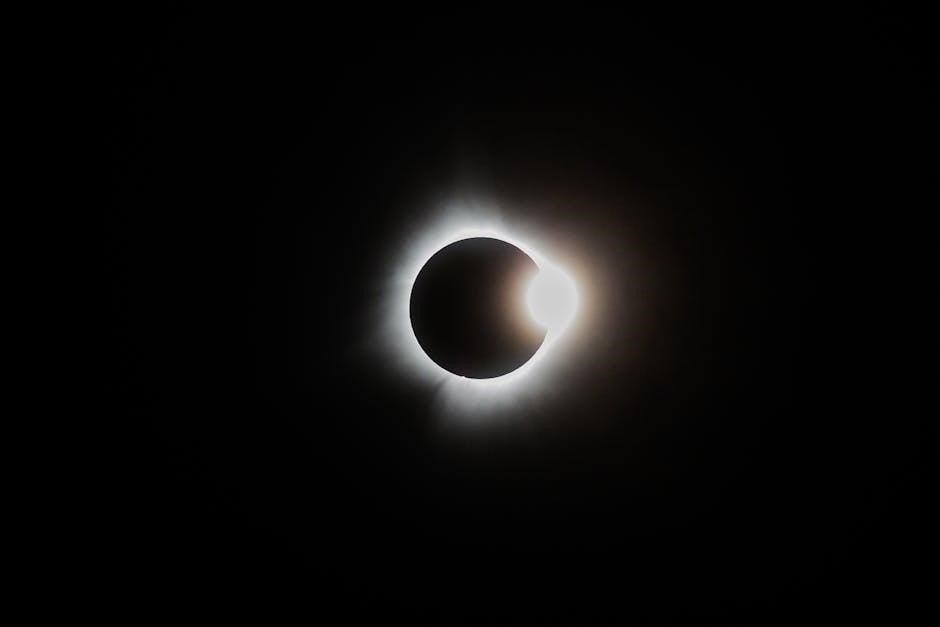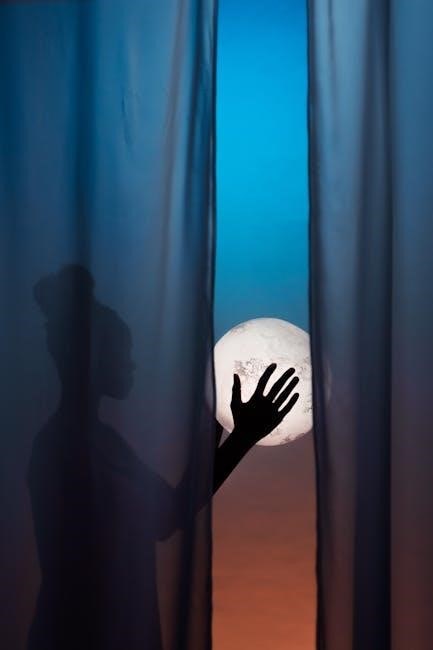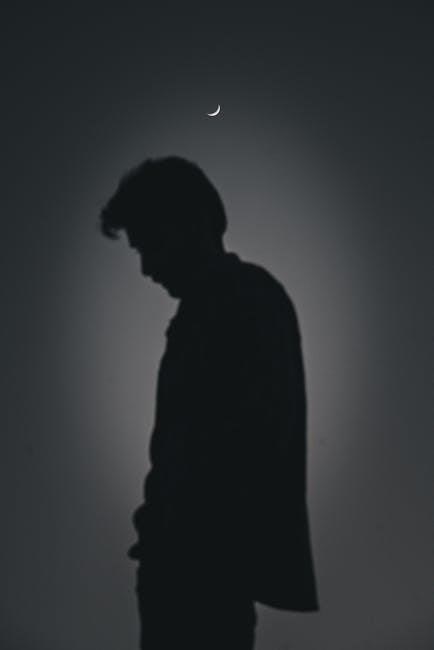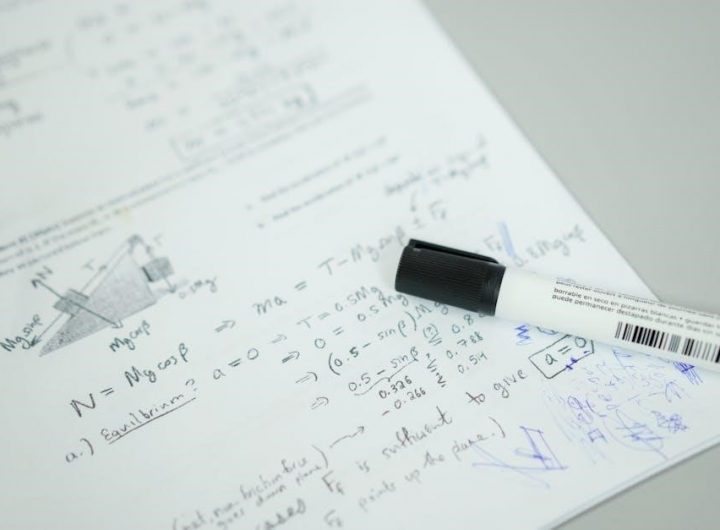
Eclipses are rare and awe-inspiring celestial events caused by the alignment of the Sun, Moon, and Earth. They occur when one object casts a shadow on another, creating a fleeting spectacle of light and darkness.
What is an Eclipse?
An eclipse occurs when one celestial body casts a shadow on another, temporarily blocking the light. This phenomenon happens when the Sun, Moon, and Earth align in a straight line. During a solar eclipse, the Moon passes between the Sun and Earth, partially or completely obscuring the Sun’s light. In a lunar eclipse, Earth positions itself between the Sun and Moon, casting its shadow on the lunar surface. Eclipses are rare because the Moon’s orbit is tilted relative to Earth’s orbital plane around the Sun. The alignment of the three bodies is precise, making eclipses fleeting yet awe-inspiring events. They offer a unique opportunity to study the behavior of light, shadows, and celestial mechanics while captivating observers worldwide.
Key Differences Between Solar and Lunar Eclipses
Solar and lunar eclipses differ fundamentally in their causes and observation methods. A solar eclipse occurs during the day when the Moon passes between the Sun and Earth, partially or completely blocking sunlight. This event happens at the new moon phase. In contrast, a lunar eclipse occurs at night during a full moon when Earth blocks sunlight from reaching the Moon. Solar eclipses are less frequent because the Moon’s shadow has a narrow path on Earth. Lunar eclipses are more common as Earth’s shadow covers a larger area. Viewing solar eclipses requires special eyewear to prevent eye damage, while lunar eclipses are safe to observe directly. These differences make each type of eclipse unique and fascinating in its own right, offering distinct experiences for observers.

Solar Eclipses
A solar eclipse occurs when the Moon passes between the Sun and Earth, casting a shadow that causes partial or total darkness during the day.
How Do Solar Eclipses Occur?
A solar eclipse occurs when the Moon moves directly between the Sun and Earth, blocking the Sun’s light. This alignment is rare due to the Moon’s tilted orbit. During a solar eclipse, the Moon’s shadow falls on a specific region of Earth, creating an observable event. The Moon’s umbra, the darker inner shadow, causes a total eclipse, while the penumbra results in a partial eclipse. Solar eclipses can only happen during a new moon when the Moon is close to one of the nodes where the ecliptic intersects Earth’s orbital plane. The duration of totality is brief, lasting a few minutes, making solar eclipses fleeting yet spectacular phenomena.
Types of Solar Eclipses: Total, Annular, and Partial
Solar eclipses are categorized into three main types: total, annular, and partial. A total solar eclipse occurs when the Moon completely covers the Sun, revealing the Sun’s glowing corona. This is the rarest and most spectacular type. An annular solar eclipse happens when the Moon is at a greater distance from Earth, appearing smaller and leaving a ring of light visible around it. A partial solar eclipse takes place when the Moon only partially covers the Sun, creating a “bite taken out of the Sun” effect. The type of eclipse depends on the Moon’s distance from Earth and its apparent size relative to the Sun. Each type offers a unique visual experience, fascinating astronomers and observers alike.
Safety Measures for Viewing Solar Eclipses

Viewing solar eclipses requires strict safety precautions to protect your eyesight. Directly looking at the Sun, even during an eclipse, can cause serious eye damage or blindness due to its intense ultraviolet and infrared rays. The only safe way to observe a solar eclipse is by using ISO-certified solar viewing glasses or handheld solar viewers. These devices have specialized filters that block 99.999% of both UV and IR radiation. Regular sunglasses or homemade filters are insufficient and unsafe. Additionally, never look at the Sun through an unfiltered telescope or camera lens. Pinhole projectors or indirect viewing methods are also recommended to avoid direct eye exposure. Always inspect your solar glasses for scratches or damage before use. Safety should never be compromised to witness this celestial event.

Lunar Eclipses
Lunar eclipses occur during a full moon when Earth is directly between the Sun and the Moon, casting its shadow on the lunar surface. This alignment creates a striking celestial event.
How Do Lunar Eclipses Occur?
A lunar eclipse occurs when the Earth positions itself between the Sun and the Moon, blocking the sunlight that normally reflects off the Moon’s surface. During a full moon, the Earth’s shadow falls on the Moon, creating the eclipse. The Earth’s shadow consists of two parts: the umbra, the darker inner shadow, and the penumbra, the lighter outer shadow. The type of lunar eclipse depends on how much of the Moon enters these shadow regions. Lunar eclipses can only happen when the Moon is full and the Earth, Moon, and Sun are aligned in a straight line. This alignment is rare because the Moon’s orbit is tilted relative to the Earth’s orbital plane around the Sun. As a result, the Earth’s shadow typically falls above or below the Moon, preventing an eclipse. When the alignment is precise, the Moon moves into the Earth’s shadow, causing the eclipse to occur. Lunar eclipses are visible from anywhere on the Earth’s night side, making them accessible to a wide audience. Unlike solar eclipses, lunar eclipses are safe to observe without special eye protection. The duration of a lunar eclipse varies, with total eclipses lasting several hours. The Moon’s appearance during a lunar eclipse can range from a faint darkening to a deep reddish hue, depending on Earth’s atmospheric conditions. Scientists and sky gazers alike find lunar eclipses fascinating because they provide insights into the Earth-Moon-Sun system and the physics of light scattering. Lunar eclipses are also significant for cultural and astronomical studies, as they have been recorded and interpreted by civilizations throughout history. By understanding lunar eclipses, we gain a deeper appreciation for the celestial mechanics that govern our universe. Observing lunar eclipses allows astronomers to study the Earth’s shadow, the Moon’s orbital patterns, and the effects of atmospheric phenomena. These events also serve as reminders of the dynamic and interconnected nature of our solar system.

Types of Lunar Eclipses: Total, Partial, and Penumbral
Lunar eclipses are categorized into three types based on how the Earth’s shadow interacts with the Moon. A total lunar eclipse occurs when the entire Moon enters the Earth’s umbra, the darker inner shadow, often giving the Moon a reddish hue due to scattered sunlight. A partial lunar eclipse happens when only a portion of the Moon enters the umbra, creating a darkened segment on the Moon’s surface. Finally, a penumbral lunar eclipse is the subtlest, where the Moon passes through the Earth’s penumbra, the lighter outer shadow, causing a slight dimming or shading that is often hard to discern. Each type varies depending on the Moon’s position relative to the Earth’s shadow, resulting in unique visual effects during the eclipse.
What Causes the Moon’s Color During a Lunar Eclipse?
During a lunar eclipse, the Moon’s color is primarily influenced by Earth’s atmospheric conditions and the scattering of sunlight. When the Moon is in the Earth’s umbra, most direct sunlight is blocked, but some light filters through the atmosphere, creating a reddish hue. This phenomenon, known as Rayleigh scattering, occurs because shorter blue wavelengths are scattered more than longer red wavelengths, leaving the Moon with a reddish appearance. Additionally, atmospheric particles like dust, water vapor, and pollutants can enhance this effect, sometimes resulting in a range of colors from deep crimson to orange or copper. This is why the Moon is often referred to as a “Blood Moon” during a total lunar eclipse, though the exact shade can vary depending on Earth’s atmospheric state at the time of the eclipse.

Frequency and Timing of Eclipses
Eclipses occur periodically due to the Moon’s orbital tilt relative to Earth’s ecliptic plane. The alignment of nodes and the Saros cycle determine their timing and recurrence patterns.
Why Don’t Eclipses Occur Every Month?
Eclipses do not occur every month because the Moon’s orbit is tilted relative to Earth’s orbital plane around the Sun. This tilt means the Moon’s shadow rarely aligns perfectly with Earth or the Sun. Eclipses can only happen when the Moon is near one of the two nodal points in its orbit during a new moon (solar eclipse) or full moon (lunar eclipse). Since the Moon’s orbit is inclined at about 5 degrees, most new and full moons do not result in eclipses. The specific alignment of the Sun, Moon, and Earth, combined with the Moon’s orbital tilt, makes eclipses relatively rare events rather than monthly occurrences.
The Saros Cycle and Eclipse Prediction
The Saros Cycle is a 6,585.32-day (approximately 18-year, 11-day, and 8-hour) period used to predict eclipses. This cycle accounts for the alignment of Earth, Moon, and Sun, as well as the Moon’s orbital phases and nodes. After one Saros Cycle, similar eclipse patterns recur, including the same types of eclipses and their timing. This periodicity allows astronomers to predict eclipses with high accuracy. The cycle incorporates 223 synodic months (lunar phases), 242 nodal periods (returns to the same node), and 241 anomalistic months (returns to the same orbital point). The Saros Cycle ensures that eclipses are not random but follow a predictable pattern, aiding in long-term celestial event forecasting and historical eclipse documentation.

Viewing and Understanding Eclipses
Understanding and viewing eclipses requires knowledge of their causes, types, and safe observation methods, enhancing appreciation for these rare celestial events and their scientific significance.
How to Safely Observe an Eclipse
Safely observing an eclipse requires proper eye protection to avoid vision damage. Use ISO-certified solar filters or hand-held solar viewers to directly view a solar eclipse. Never look at the Sun without protection, even during an eclipse, as it can cause severe eye damage or blindness. For lunar eclipses, no special eye protection is needed, but binoculars can enhance the viewing experience. Ensure all equipment meets safety standards before use. Understanding these precautions ensures a safe and enjoyable observation of these rare celestial events.
The Scientific Significance of Studying Eclipses
Studying eclipses provides invaluable insights into celestial mechanics and astronomical phenomena. Solar eclipses allow scientists to study the Sun’s corona, which is usually obscured by the Sun’s bright light. This helps researchers understand solar wind, magnetic fields, and the Sun’s outer atmosphere. Lunar eclipses offer opportunities to analyze Earth’s shadow and its effects on the Moon’s surface, revealing details about the Moon’s geology and Earth’s atmospheric composition. Eclipses also help test theories, such as Einstein’s general relativity, which predicts gravitational effects on light during solar eclipses. Additionally, studying eclipse patterns aids in understanding long-term celestial alignments and improving predictive models for future events. These studies contribute to a deeper understanding of our solar system’s dynamics and evolution.
 king of the underworld rj kane pdf
king of the underworld rj kane pdf  mark cousins the story of film pdf
mark cousins the story of film pdf  algebra workbook pdf
algebra workbook pdf  the other end of the leash pdf
the other end of the leash pdf  schedule pipe chart pdf
schedule pipe chart pdf  l tec 225 mig welder parts manual pdf
l tec 225 mig welder parts manual pdf  merlin home transmitter manual
merlin home transmitter manual  contrat de sous-location québec pdf
contrat de sous-location québec pdf